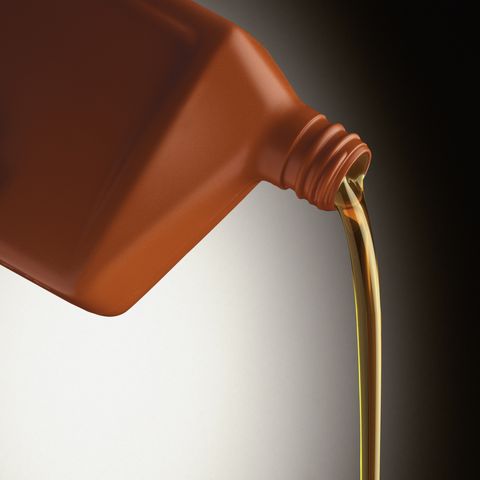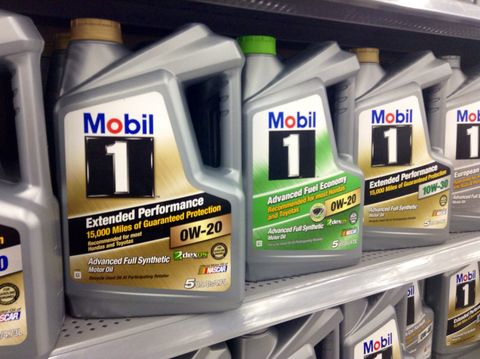How To Pick The Right Motor Oil For Your Car
There are many choices when it comes to picking the appropriate oil for your car's engine. Our guide breaks down your choices to help you in the quest to change your oil.
By Paul Weissler And Popular Mechanics Editors GETTY IMAGES/BILL HEINSOHN
GETTY IMAGES/BILL HEINSOHNGiven all the motor oil options out there, choosing the right oil for your car might seem like an impossibly daunting task. While there is a mountain of info to learn about the various oil choices, the first step is honestly quite simple: look in the manual.
Your car's owner's manual will list the recommend oil weight, whether that's a standard like 10W-30 or something more unusual. Later on, we'll explain what that weight means how you should adjust it based on the seasons. But for now, choose an oil with the recommended weight from a brand that displays the starburst symbol that indicates the oil has been tested by the American Petroleum Institute (API). In addition, there's a 2-character service designation on the container. API's latest service standard is "SL." SL refers to a group of laboratory and engine tests, including the latest series for control of high-temperature deposits.
Next, you need to choose the viscosity (thickness) that's suitable for the temperatures your vehicle normally operates in (again, check your owners manual).
Those are the basics. But there's a whole lot more to the story than that.
Understand the Labels

SAE
These are the labels you'll find on every container of reputable motor oil. The API donut on the right tells you if the oil meets the current SL service rating (C for diesel engines). It also provides the SAE (Society of Automotive Engineers) viscosity number and tells you if the oil has passed the Energy Conserving test. The starburst symbol on the left indicates that the oil has passed the tests listed for SL service.
Viscosity
Viscosity means a fluid's resistance to flow. In motor oil, it's rated at 0° F (represented by the number preceding the "W" [for Winter]) and at 212° F (represented by the second number in the viscosity designation). Motor oil thins as it heats and thickens as it cools. So, with the right additives to help it resist thinning too much, an oil can be rated for one viscosity when cold, another when hot. The more resistant it is to thinning, the higher the second number (10W-40 versus 10W-30, for example) and that's good. Within reason, thicker oil generally seals better and maintains a better film of lubrication between moving parts.
At the low-temperature end, oil has to be resistant to thickening so that it flows more easily to all the moving parts in your engine. Also, if the oil is too thick, the engine requires more energy to turn the crankshaft, which is partly submerged in a bath of oil. Excessive thickness can make it harder to start the engine, which reduces fuel economy. A 5W oil is typically what's recommended for winter use. However, synthetic oils can be formulated to flow even more easily when cold, so they are able to pass tests that meet the 0W rating.
Once the engine is running, the oil heats up. The second number in the viscosity rating—the "40" in 10W-40, for example—tells you that the oil will stay thicker at high temperatures than one with a lower second number—the "30" in 10W-30, for example. What's really important is that you use the oil viscosity your car's owner's manual recommends.

MIKE MOZART - FLICKR CC
Look on the shelves in auto parts stores and you'll see oils labeled for all kinds of specific purposes: high-tech engines, new cars, higher-mileage vehicles, heavy-duty/off-road SUVs. In addition, you'll see a wide selection of viscosities. If you read your owner's manual, you'll know what the car manufacturer recommends for a brand-new vehicle. The manual may include a reference to Energy Conserving oils, which simply means that the oil has passed a lab test against a reference oil. It's no guarantee of better fuel economy, but most of the leading brands have at least some viscosities that are so labeled. Let's take a look at the different types.
How to Choose Between Synthetic and Conventional Motor Oil
Premium Conventional Oil: This is the standard new-car oil. All leading brands have one for service level SL, available in several viscosities. The carmakers usually specify a 5W-20 or 5W-30 oil, particularly for lower temperatures, with a 10W-30 oil as optional, particularly for higher ambient temperatures. These three ratings cover just about every light-duty vehicle on the road. Even more important, though, is changing the oil and filter regularly. A 4000 miles/4 months interval is good practice. The absolute minimum is twice a year. If your car has an electronic oil-change indicator on the instrument cluster, don't exceed its warning.
Full Synthetic Oil: The oils made for high-tech engines, whether in a Chevy Corvette or Mercedes-Benz, are full synthetics. If these oils pass stringent special tests (indicated by their labeling), it means they have superior, longer-lasting performance in all the critical areas, from viscosity index to protection against deposits. They flow better at low temperatures and maintain peak lubricity at high temperatures. So why shouldn't everyone use them? Answer: These oils are expensive and not every engine needs them. In fact, there may be some features that your car's engine needs that the synthetics don't have. Again, follow your owner's manual.
Synthetic Blend Oil: These have a dose of synthetic oil mixed with organic oil, and overall are formulated to provide protection for somewhat heavier loads and high temperatures. This generally means they're less volatile, so they evaporate far less, which reduces oil loss (and increases fuel economy). They're popular with drivers of pickups/SUVs who want the high-load protection. And they're a lot less expensive than full synthetics, maybe just pennies more than a premium conventional oil.
Higher Mileage Oil: Today's vehicles last longer, and if you like the idea of paying off the car and running the mileage well into six figures, you have another oil choice, those formulated for higher-mileage vehicles. Almost two-thirds of the vehicles on the road have more than 75,000 miles on the odometer. So the oil refiners have identified this as an area of customer interest, and have new oils they're recommending for these vehicles.
When your car or light truck/SUV is somewhat older and has considerably more mileage, you may notice a few oil stains on the garage floor. It's about this time that you need to add a quart more often than when the vehicle was new. Crankshaft seals may have hardened and lost their flexibility, so they leak (particularly at low temperatures) and may crack. The higher-mileage oils are formulated with seal conditioners that flow into the pores of the seals to restore their shape and increase their flexibility. In most cases, rubber seals are designed to swell just enough to stop leaks. But the oil refiners pick their "reswelling" ingredients carefully. Valvoline showed us the performance data of one good seal conditioner that swelled most seal materials, but actually reduced swelling of one type that tended to swell excessively from the ingredients found in some other engine oils.
You also may have noticed some loss of performance and engine smoothness as a result of engine wear on your higher-mileage vehicle. These higher-mileage oils also have somewhat higher viscosities. (Even if the numbers on the container don't indicate it, there's a fairly wide range for each viscosity rating and the higher-mileage oils sit at the top of each range.) They also may have more viscosity-index improvers in them. The result? They seal piston-to-cylinder clearances better, and won't squeeze out as readily from the larger engine bearing clearances. They also may have a higher dose of antiwear additives to try to slow the wear process.
If you have an older vehicle, all of these features may mean more to you than what you might get from a full synthetic, and at a fraction the price.
Beyond that, there's plenty more to the oil story. Read on.
Going Deeper

ADRIAN BLACK - FLICKR CC
Resistance to thinning with increasing temperature is called viscosity index. And although a higher second number is good, the oil also has to be robust. That is, it must be able to last for thousands of miles until the next oil change. For example, oil tends to lose viscosity from shear, the sliding motion between close-fitted metal surfaces of moving parts such as bearings. So resistance to viscosity loss (shear stability) is necessary to enable the oil to maintain the lubricating film between those parts.
Unlike antifreeze, 95 percent of which is made up of one base chemical (typically ethylene glycol), petroleum-type engine oil contains a mixture of several different types of base oil, some more expensive than others. Oil companies typically pick from a selection of five groups, each of which is produced in a different way and in different viscosities. The more expensive groups are more highly processed, in some cases with methods that produce a lubricant that can be classified as a synthetic. The so-called full synthetics contain chemicals that may be derived from petroleum but they're altered so much that they're not considered natural oil anymore. Our custom blend contained 10 percent polyalphaolefins (PAO), the type of chemical that's often the primary ingredient in a full synthetic.
The base oil package in any oil makes up anywhere from 70 to 95 percent of the mix, the rest comprised of additives. Does that mean an oil with just 70 percent base oils is better than one with 95 percent. No, because some of the base oils have natural characteristics or ones that derive from their processing, which reduces or eliminates the need for additives. And although some additives make important contributions to lubrication, by themselves don't necessarily have great lubricity.
The ingredients in an additive package differ in cost, as we said, but price is just one factor. Some work better in certain combinations of base oils, and some of the less-expensive base oils are a good choice for a blend because of the way they perform with popular additives. Bottom line: every motor oil has a recipe. Refiners come up with a list of objectives based on the needs of their customers (the carmakers, for example) and formulate oil to meet those goals as best they can.
Now, keeping an oil from thinning as it gets hot while it takes a beating from engine operation is one thing. But it's also important to keep oil from getting too thick. Using premium base oils for low volatility--to prevent evaporation--is one approach. Evaporation of the base oil package not only increases oil consumption, it results in thicker oil (which decreases fuel economy).
Oil Additives
Use of additives is another approach to improving and maintaining oil performance. High engine temperatures combine with moisture, combustion byproducts (including unburned gasoline), rust, corrosion, engine wear particles and oxygen to produce sludge and varnish. The additives not only assist oil in maintaining good lubrication, they also help minimize sludge and varnish, and any damage from their formation. Here are the categories of key additive ingredients and why they're important:
• Viscosity-index improvers: Reduce the oil's tendency to thin with increasing temperature.
• Detergents: Unlike the household type, they don't scrub engine surfaces. They do remove some deposits, primarily solids. But their main purpose is to keep the surfaces clean by inhibiting the formation of high-temperature deposits, rust and corrosion.
• Dispersants: Disperse solid particles, keeping them in solution, so they don't come together to form sludge, varnish and acids. Some additives work both as detergents and dispersants.
• Antiwear agents: There are times when the lubricating film breaks down, so the antiwear agents have to protect the metal surfaces. A zinc and phosphorus compound called ZDDP is a long-used favorite, along with other phosphorus (and sulphur) compounds. If you musts know, ZDDP stand for zinc diakyl dithiophosphate.
• Friction modifiers: These aren't the same as antiwear agents. They reduce engine friction and, so, can improve fuel economy. Graphite, molybdenum and other compounds are used.
• Pour-point depressants: Just because the 0° F viscosity rating is low doesn't mean the oil will flow readily at low temperatures. Oil contains wax particles that can congeal and reduce flow, so these additives are used to prevent it.
• Antioxidants: With engine temperatures being pushed up for better emissions control, the antioxidants are needed to prevent oxidation (and, therefore, thickening) of oil. Some of the additives that perform other functions also serve this purpose, such as the antiwear agents.
• Foam inhibitors: The crankshaft whipping through the oil in the pan causes foaming. Oil foam is not as effective a lubricant as a full-liquid stream, so the inhibitors are used to cause the foam bubbles to collapse.
• Rust/corrosion inhibitors: Protect metal parts from acids and moisture.
More Is Not Better
You can't necessarily improve an oil by putting in more additives. In fact, you can make things worse. For example, sulphur compounds have antiwear, antioxidation characteristics, but they can reduce fuel economy and affect catalytic converter operation. Too much of a particular detergent could affect the antiwear balance. Too much of a specific dispersant could affect catalyst performance and reduce fuel economy. Antiwear and friction-reducing additives also may have ingredients (such as sulphur) that could affect catalyst performance.
There's a lot of pressure on the oil industry to reduce sulphur content in oil as well as gasoline. But the industry's resistance is understandable when you consider the delicate balancing act it must perform with each revolution of your car's engine.
Don't Forget the Filter
Oil filters are a completely different, albeit related, subject when it comes to changing your oil. Again, it's always best to consult with your carmaker on the type of filter required. Some aftermarket filters are larger, so make sure if you use one of those, that you have enough oil.
Random Things: Right Motor Oil >>>>> Download Now
ReplyDelete>>>>> Download Full
Random Things: Right Motor Oil >>>>> Download LINK
>>>>> Download Now
Random Things: Right Motor Oil >>>>> Download Full
>>>>> Download LINK Ju